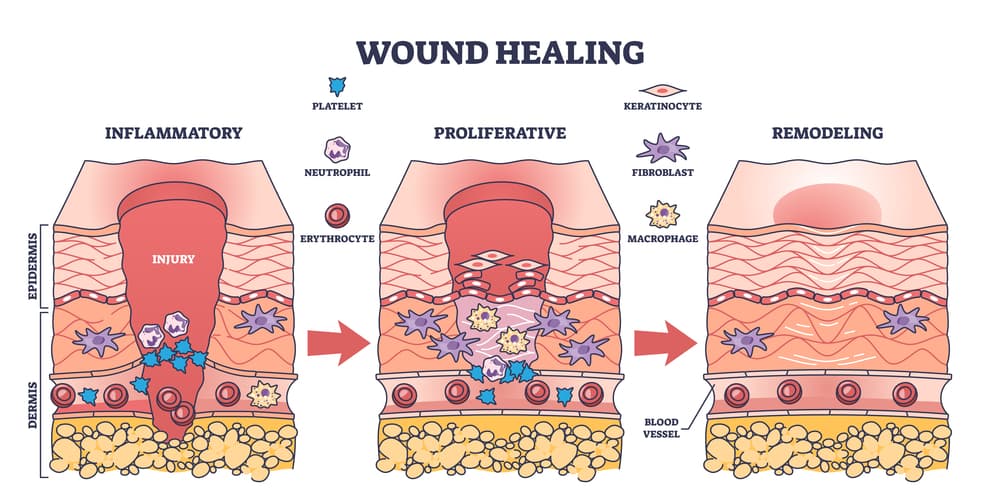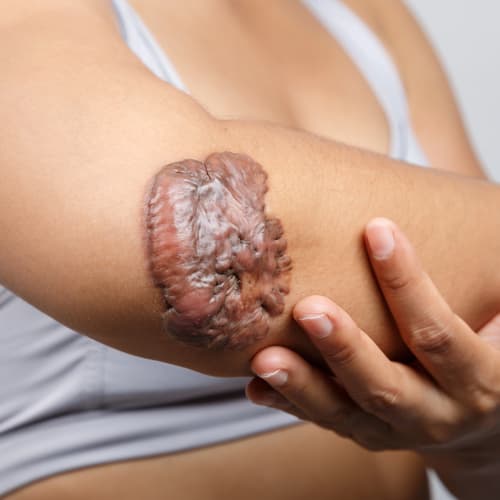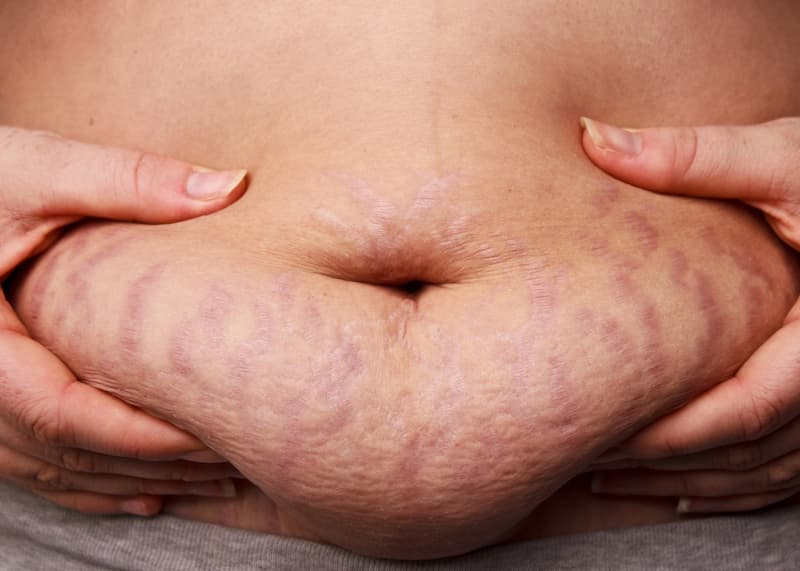Scars, whether from surgery or acne, are a constant reminder of past injuries. When scars become pathological, as in the case of keloids, they can significantly affect both the aesthetic appearance and psychosocial well-being, impacting self-esteem and causing physical discomfort.
The growing emphasis on scar reduction and patient satisfaction has fueled ongoing research of stem cells in scar treatment as a promising source for tissue repair and regeneration, since traditional scar treatments often fail to effectively address deeper skin issue. Can stem cells repair scar tissue? This is the question we will explore in this article.
Understanding Scars: Causes and Challenges
Skin has a limited ability to repair after injury that penetrates beyond the epidermis. A cutaneous wound heals by forming a scar made of connective tissue. In addition to having a different appearance, which may be undesirable, the scar tissue does not function like the surrounding skin. This natural healing process affects people worldwide, and more than 11 million people are affected by keloid-related problems.

The process of healing a skin injury is generally similar across scar types, but it can be “disrupted” in different ways depending on factors like the injury’s depth, the body’s response, and other variables. This imbalance can lead to different types of scars.
- In some cases, the body produces too much collagen, leading to raised scars like keloids or hypertrophic scars.
- On the other hand, not enough collagen can be produced, leading to atrophic scars, such as pitted or sunken scars.
- Chronic inflammation during healing can lead to improper tissue remodeling, which affects the final appearance of the scar.
- Abnormal growth of skin cells or fibroblasts (the cells that produce collagen) can result in scars that don’t align with the surrounding tissue.
Can stem cells heal scar tissue in these cases? Stem cells can address the different imbalances in the normal healing process by promoting proper tissue regeneration.
Benefits of Stem Cell for Scar Treatment
When traditional therapy, such as laser treatment or chemical peels, is not effective, stem cell scar treatment offers a promising alternative. These cells play a key role in the body’s natural healing process, promoting regeneration while reducing scar formation.
Stem cell therapy works in several ways:
- Improve tissue regeneration and reduce inflammation
- Help to form healthy blood vessels
- Improve collagen regulation and skin structure
- Contribute to faster wound healing with less contraction
But can stem cells repair scar tissue? Rather than claiming that stem cells remove scars, this therapy supports the regeneration process and helps repair by replenishing necessary resources.
Is Stem Cell Therapy Effective for All Types of Scars?
Recent studies show that stem cell therapy affects scars differently depending on their type. While the treatment looks promising, its success depends on factors such as the age, depth, and type of the scar.
Stem cell therapy works best for:
- Hypertrophic scars and keloids
- Burn scars
- Surgical scars
- Acne scars.
Get a free online consultation
Each case is unique. Schedule a free consultation today to find the treatment plan that’s right for you. Fill out the form below to get started quickly.

Medical Advisor, Swiss Medica doctor
Real Results for Different Types of Scars: How Can Stem Cells Heal Scar Tissue?
Mesenchymal stem cells (MSCs) can be involved in the three phases of wound healing. Which is also why this therapy is showing promising results in healing various types of scars, particularly those that are difficult to treat with conventional methods.
Stem cells for acne scar treatment
Stem cells for acne scars can promote skin regeneration and reduce the appearance of deep, pitted acne scars by stimulating collagen production and improving skin texture.
Stem cells for surgical scars
After surgery, scars can form due to the body’s healing process. Stem cell therapy for scar tissue can help in remodeling the skin and reducing the visibility of scars by improving cellular turnover and healing.
Stem cells for keloid scars
Keloids are thick, raised scars that can be difficult to treat. Stem cell scar treatment may help prevent or reduce the overproduction of collagen, thus preventing keloid formation or diminishing existing keloids.

Stem cells for stretch marks (striae)
Stretch marks are a form of scarring that occurs when the skin stretches rapidly. Stem cells for scar removal can stimulate the regeneration of skin tissue and improve the appearance of stretch marks by promoting healing and collagen production.

The Science Behind Stem Cell Therapy for Scar Tissue Healing
Stem cells for scar treatment remain a topic of active research, especially in terms of how effectively stem cells remove scars.
Can stem cells reduce scar tissue? Recent studies have shown promising therapy results in using stem cells for scar tissue reduction. For example, fat-derived stem cells (adipose-derived stem cells) have been particularly effective in promoting skin renewal and minimizing scar visibility.
In another study, researchers found that adipose-derived stem cells for scar tissue therapy significantly improve the appearance of hypertrophic scars and keloids. Patients reported reductions in scar size following treatment. The treatment is particularly effective for improving all aspects of scars, including color, elasticity, texture, and thickness.
Research shows that stem cells boost healing through direct cell differentiation and paracrine mechanisms. They don’t just work on the surface—they reach deep into tissue layers to provide detailed healing.
Regenerative medicine uses different types of stem cells to treat a wide range of conditions. For more information about stem cells, just follow this link.
Learn moreMechanisms of Action of Adipose-Derived Stem Cells (ADSCs)
| Promotion of Angiogenesis | ADSCs enhance blood vessel formation, improving nutrient delivery to scar tissue. |
| Anti-inflammatory Properties | Stem cells for scar removal have an anti-inflammatory effect, preventing excessive inflammation that significantly affects the development of abnormal scarring. |
| Collagen Modulation | Stem cells remove scars by acting on various growth factors and collagen production, which encourages the skin to heal and return to its normal structure. |
Scientifically Proven Success Stories
Can stem cells be used for acne scars? Scientists have conducted a case study on a patient with this condition to explore its viability.
A 35-year-old woman with severe acne scars on both cheeks underwent a combination treatment with adult stem cells for acne scars. The scars included ice pick, boxcar, and rolling scars, and her skin was loose and sagging.
The procedure of stem cell acne scar treatment was minimally invasive with local anesthesia, and the results were impressive. After 14 days there was significant improvement in all types of scars; the skin was smoother and firmer with reduced laxity, the skin was brighter and more hydrated, elasticity was improved by 80%, and after 6 months the patient experienced at least 80% improvement in scar appearance and skin quality.
Why Choose Stem Cell Therapy Over Traditional Treatments?
There are several advantages to choosing stem cells for scar treatment over traditional therapy methods, including:
- Stem cell therapies are minimally invasive, which minimizes risks as opposed to other more invasive treatments.
- Traditional treatments, such as laser therapy or surgical removal, may sometimes lead to additional scarring. Stem cells for surgical scars can help reduce the risk of further scarring by modulating the body’s inflammatory response and promoting proper healing.
- The main advantage of how stem cells ‘reduce’ scar tissue lies in their ability to restore the body’s natural healing mechanisms.
- The stem cells for scar repair stimulate the production of healthy tissue and collagen, leading to smoother, less noticeable scars and making the skin more elastic.
- The therapy can reduce the inflammation associated with scarring and help alleviate the pain or discomfort that some people experience with traditional treatments. This effect is particularly useful in stem cell therapy for acne scars, making the recovery process more comfortable and easier to tolerate.
Did you know that stem cells are carefully prepared to ensure maximum effectiveness before treatment? Learn more about each step of this process.
Learn moreHow to Choose a Reliable Clinic for Stem Cell Scar Treatment?
When choosing a clinic, it is important to consider the reputation of the facility, experience in treatment, and regenerative medicine.
Swiss Medica has specialized in advanced stem cell treatments since 2011.
- Our modern five-building hospital in Belgrade is designed to provide exceptional care. Conveniently located just 15 minutes from the airport, it is an ideal choice for international patients.
- Our treatment package includes an individualized approach to each patient, comprehensive stem cell therapy, and accommodation—all for one price.
- There are only 3 patients per doctor in our clinic, which allows for individual and detailed attention to our patients.
- From the moment you arrive, we will take care of everything to make your trip seamless. We offer airport transfers and a comfortable hotel-like environment designed for rest and recuperation. Our customized menus are designed for individual preferences and diets.
Preparing for Your Stem Cell Treatment: What to Expect
The treatment at Swiss Medica always begins with an examination, where doctors assess your condition and determine whether cell therapy is safe for you.
The stem cell scar treatment primarily involves the use of adult stem cells, which include adipose stem cells and mesenchymal stem cells, as well as exosomes and other derivatives. Both your own and donor cells can be used, with the method of administration tailored to each individual case.
How Stem Cells are Applied for Scar Removal
At Swiss Medica, one of the following methods is usually used to introduce stem cells for scar removal:
Direct Injection
Stem cells, usually derived from adipose tissue or bone marrow, are directly injected into the area of the scar. These stem cells work by promoting tissue regeneration and neoangiogenesis. They help reduce scar tissue and encourage the formation of healthy skin cells. This method is commonly used in stem cells for surgical scar management.
Stem Cell-Infused Creams or Gels
Topical treatments containing stem cell-derived growth factors can be applied to the skin. Such techniques are used in stem cell acne scar treatment, helping to stimulate cell turnover and improve the texture of the skin.
Are There Any Risks Associated with Stem Cell Therapy for Scars?
Stem cells for acne scars or other types of scars are generally safe, with minimal adverse effects. Clinical studies report that approximately 8% of patients show mild reactions, such as mild fever or pain at the injection site, which are usually temporary and subside quickly.
However, as with any medical treatment, there are potential risks and side effects. For this reason, it’s important to consult with a qualified stem cell therapy professional before proceeding with treatment to ensure that it is appropriate for your specific condition.
The adult MSCs that we use at Swiss Medica also do not carry a cancer risk, such as embryonic cells, which we never use.
How Long Does It Take for Scars to Fade After Treatment?
Can stem cells reduce scar tissue over time? This new study by British scientists notes that patients typically see significant improvements in scar appearance within a few weeks to months after stem cell scar treatment, with ongoing benefits as the skin continues to heal and remodel. On average, the results are seen within 6 months.
Cost and Accessibility of Stem Cell Therapy for Scars
The cost of stem cell therapy for scar treatment can vary depending on the type of procedure, the clinic, and the clinic location.
Stem cells for scar tissue therapy typically range from $5,000 to $50,000 per session, depending on the type of treatment and the country where the procedure is performed. In some cases, multiple sessions may be required, increasing the overall cost.
The cost of stem cell scar treatment at Swiss Medica is generally more accessible, with prices typically ranging from €7,000 to €31,000* per course of treatment, including accommodation costs.
*The prices mentioned are indicative and subject to change based on individual factors, including the condition’s severity and the number of stem cells needed. Prices are valid as of January 2025
Frequently Asked Questions
1. What is the typical duration of the recovery period?
The recovery period following stem cells for scar repair is typically short, with the majority of patients able to resume their normal activities within a few days. Any transient soreness or swelling typically dissipates rapidly.
2. Can stem cells remove scars that are years old?
At Swiss Medica, we only use adult multipotent mesenchymal stem cells for scar tissue. The main function of MSCs is to stop damage processes. Once in the body, they begin to produce various active molecules that help cells migrate and adhesion molecules that regulate cell interaction at the microscopic level. Thanks to this ability, MSCs can support the healing process regardless of the scar’s age.
Contact us
Have more questions? Fill out the form below, and a regenerative medicine expert will contact you to provide the answers you need.

Medical Advisor, Swiss Medica doctor
List of References
Almadori A, Butler PE. Scarring and Skin Fibrosis Reversal with Regenerative Surgery and Stem Cell Therapy. Cells. 2024. doi:10.3390/cells13050443 https://pubmed.ncbi.nlm.nih.gov/38474408/
Li Q, Zhang C, Fu X. Will stem cells bring hope to pathological skin scar treatment? Cytotherapy. 2016 Aug;18(8):943-956. doi:10.1016/j.jcyt.2016.05.008 2016.
Kosheeka. Use Stem Cells For Healing Scars. 2024 https://www.kosheeka.com/stem-cells-to-heal-scars/
Stachura A, Paskal W, Pawlik W, Mazurek MJ, Jaworowski J. The Use of Adipose-Derived Stem Cells (ADSCs) and Stromal Vascular Fraction (SVF) in Skin Scar Treatment-A Systematic Review of Clinical Studies. J Clin Med. 2021. doi:10.3390/jcm10163637 https://www.ncbi.nlm.nih.gov/pmc/articles/PMC8396936/
Frontiers | Use of Adipose Stem Cells Against Hypertrophic Scarring or Keloid, 2024. https://www.frontiersin.org/journals/cell-and-developmental-biology/articles/10.3389/fcell.2021.823694/full
Harward. Healing without scars, 2024. https://hsci.harvard.edu/news/healing-without-scars
Ruchee Phonchai, Pimjai Naigowit, Bunchob Ubonsaen, Supansa Nilubol, Supaluk Brameld, Parinya Noisa Improvement of Atrophic Acne Scar and Skin Complexity by Combination of Aqueous Human Placenta Extract and Mesenchymal Stem Cell Mesotherapy Journal of Cosmetics, Dermatological Sciences and Applications, 2020. https://www.scirp.org/journal/papercitationdetails?paperid=98080&JournalID=530
Jackson, W.M., Nesti, L.J. & Tuan, R.S. Mesenchymal stem cell therapy for attenuation of scar formation during wound healing. Stem Cell Res Ther 2012. https://doi.org/10.1186/scrt111
Bojanic, C., To, K., Hatoum, A. et al. Mesenchymal stem cell therapy in hypertrophic and keloid scars. Cell Tissue Res 2021. https://doi.org/10.1007/s00441-020-03361-z
MD, Pediatrician, Regenerative Medicine Specialist







